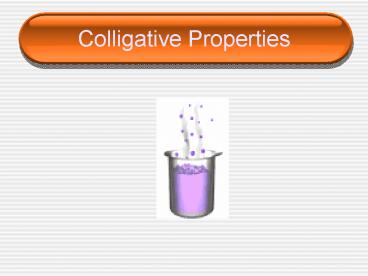Colligative Properties - PowerPoint PPT Presentation
Title:
Colligative Properties
Description:
Colligative Properties Colligative Properties _____ physical properties of solutions that are affected only by the number of particles NOT the identity of ... – PowerPoint PPT presentation
Number of Views:75
Avg rating:3.0/5.0
Title: Colligative Properties
1
Colligative Properties
2
Colligative Properties
- _______________ physical properties of
solutions that are affected only by the number of
particles NOT the identity of the solute - They include
- Vapor Pressure _______________
- Boiling Point _______________
- Freezing Point _______________
- Osmotic Pressure
- In all of these we will be comparing a pure
substance to a mixture
3
Non-Electrolyte solutions
- _______________ - solution is one where the
solute particles do not dissociate to any degree
when then are dissolved in the solvent - This is usually in a covalent compound
4
Vapor Pressure Lowering
- _______________ the pressure exerted in a closed
container by liquid particles that have escaped
to the surface and entered the gas phase
5
Vapor Pressure Lowering
- Changes related to lowering of vapor pressure are
governed by Raoults law, and fall into two
categories. - Those where the solute is non-volatile
- those where the solution has two volatile
components.
6
Raoults law
- The presence of a nonvolatile solute lowers the
vapor pressure of the solvent. - VP solution X solvent Psolvent
- VP solution VP of the solution
- X solvent mole fraction of the solvent
- P solvent VP of the pure solvent
7
Example
- At a given temperature water has a vapor pressure
of 22.80 mmHg. Calculate the vapor pressure above
a solution of 90.40 g of sucrose (C12H22O11) in
350.0 mL of water, assuming the water to have a
density of 1.000 g/mL.
8
Another example
- 23.00 g of an unknown substance was added to
120.0 g of water. The vapor pressure above the
solution was found to be 21.34 mmHg. Given that
the vapor pressure of pure water at this
temperature is 22.96 mmHg, calculate the Molar
Mass of the unknown.
9
Another Example
10
A solution with two volatile components
- Modified Raoults law
- VPT XAPA XBPB
11
Example
- At 20.0 oC the vapor pressures of methanol
(CH3OH)and ethanol (C2H5OH) are 95.0 and 45.0
mmHg respectively. An ideal solution contains
16.1 g of methanol and 92.1 g of ethanol.
Calculate the vapor pressure.
12
Boiling Point Elevation
- _______________ - point at which enough energy
has been added to overcome the intermolecular
forces that hold the solute in the solution.
13
Boiling Point Elevation
- The boiling point of a mixture is higher that the
boiling point of a pure substance - The difference in boiling points can be
calculated by the equation - ?Tb Kb m (i)
14
Boiling Point Elevation
- ?Tb Kb m (i)
- ?Tb change in boiling point (boiling point
elevation) - Kb Boiling point elevation constant (will
always get form chart) - m molality
- i vant Hoff factor number of particles that
the molecule breaks into
15
Kb
- Kb will always be given to you in the chart along
with the solutions boiling point
16
molality (m)
- molality moles solute / kg solvent
- What is the molality of a solution with 4.5 g of
NaCl dissolved in 100.0 g of H2O?
17
vant Hoff Factor (i)
- See if the compound is ionic or molecular.
18
vant Hoff Factor (i)
- For example
- What will be the ion factor in the following
compounds - C6H12O6
- NaCl
- CaCl2
- Na3PO4
19
Freezing Point Depression
- _______________ - point where enough energy has
been removed from the solution to slow the
molecules down and increase intermolecular forces
so the solution becomes a solid
20
Freezing Point Depression
- The freezing point of a mixture is lower that the
freezing point of a pure substance - The difference in freezing points can be
calculated by the equation - ?Tf Kf m (i)
21
Freezing Point Depression
- ?Tf Kf m (i)
- ?Tf change in freezing point (freezing point
depression) - Kf Freezing point depression constant (will
always get form chart) - m molality
- i number of particles that the molecule breaks
into
22
Kf
- Kf will always be given to you in the chart along
with the solutions freezing point
23
Calculations with BPE FPD
- What are the boiling points and freezing points
of a 0.029 m aqueous solution of NaCl?
24
BP FP
- What are the boiling point freezing point of a
0.050 m solution of a non-electrolyte in ethanol?
25
What is Osmosis?
- Suppose a salt solution and water are separated
by a semipereable membrane - Water will move through the membrane from into
the salt solution to equalize the concentrations
on each side of the membrane. - This is osmosis
26
Osmotic Pressure
- The minimum pressure that stops the osmosis is
equal to the osmotic pressure of the solution
27
Osmotic Pressure Calculations
- ? MRT
- ? osmotic pressure
- M molarity
- R 0.0821
- T Temperature































